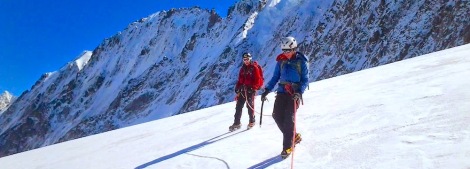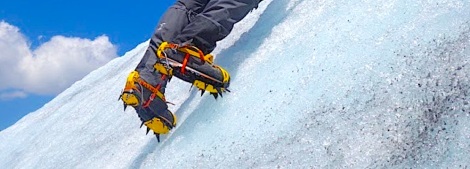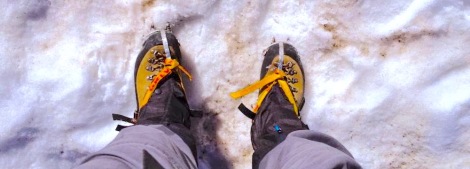
“To B3, or not to B3, that is the question”. Apologies for the awful pun (we really aren’t), but increasingly it’s challenged. Sorry, not sorry, but if you are one of those challengers, you’ll soon be directed to this blog post. Our kit lists for Mont Blanc, and similar Alpine climbs including Dufourspitze or Gran Paradiso, all list B3 boots. Every week someone calls to challenge it. Yes, there are videos on YouTube people running up Mont Blanc in trainers (link), but if you’re booked on a course, it’s highly unlikely you are called Kilian Jornet, the elite athlete sponsored by Salomon who set the return speed record on Mont Blanc of 4h57min from Chamonix church to the summit and back.
So what about the B2 boots, that you’ve used on Kilimanjaro / Ben Nevis / etc, and which were fine? Well, they will accept a crampon for sure, but the level of insulation is a fraction of that in a B3 boot, and they are more bendy. The consequence is that on snow routes such as Mont Blanc, they are more pre-disposed to shed a rigid crampon, are colder, and offer less ankle support. Why would you consider them rather than a B3? The only answer is because they are lighter. If you argue that the weight difference between a B2 and B3 is critical to you, it’s a huge alarm bell of concern for us as to your fitness and summit chances, let alone pre-requisite experience.

“Oh, but my mate did Mont Blanc in some B2’s last year, and he said they were fine”. Great, but we can’t guarantee the weather or snow condition (freezing level, saturation, stability, etc) of the precise summit day you have, so what if it’s colder / deeper fresh snow / wetter snow? The obvious answer, is that in these conditions, a B2 could jeopardise your summiting chances, and a B3 could be the difference between success and failure. Yes, we know Kilian ran up Mont Blanc in trainers, but he chose his day and precise weather window within that day, and is an elite mountaineer.
“But I don’t want to rent / hire B3’s, as they won’t be as comfy as my B2’s”. This is one of the greatest fallacies, as B3’s having a stiff shank in the sole to reduce flexibility, consequently reduces foot movement and therefore blistering. This is further aided by the fact that the thicker insulation layer within the B3 boot, pads your foot even more, aided by your thicker summit day socks. A pair of B2 boots take ‘breaking in’, which never really happens with a B3 boot. The insulation just moulds to your feet.

“But I’m going to the Matterhorn / Eiger”. Well, that’s a whole different ball game, as they are largely rock routes, with sections of snow. On these routes, snow is the enemy, and drier conditions are better and safer. The amount of time you are wearing crampons is far less, the amount of technical climbing where you require better sensitivity with your boots is far more, and you need better balance and speed than on a snow climb. On technical climbs, such as Matterhorn or Eiger, or other classic mixed routes, you will generally be better off in a pair of well broken in B2’s. If you want to climb these types of routes, and ask to hire some B3’s, again those warning bells will ring, as it’s a genuinely good gauge of experience to see if someone wanting to climb these levels of route has their own boots or not.
As you’ll see, there is flexibility in the B3 debate, but here’s one deciding question for you to answer; “Are you willing to risk your summit or not, based on your guess of what the weather will be like on a particular moment of a particular day, on a particular month?”. Based on the fact that we generally can’t predict accurately what it will be like at home more than a day or two away, if you want to argue the B2 / B3 decision months ahead for an altitude climb, you’re a gambler and probably have a pocket full of betting slips and lottery tickets too. We don’t gamble with your summit chances, and try and manage risk to the best of our ability. Equally we don’t want your climbing partner to ruin your chances either, by not being suitably equipped. For an Alpine snow route our advice is always a B3 boot, to respect the mountain, respect the changeable conditions, and to respect each other to maximise your chances.

If you are highly experienced, such as an IFMGA mountain guide, then you can make the B3 / B2 decision yourself on a snow route. Bear in mind that many guides have reached the summit of the likes of Mont Blanc well over 100 times, so they know the conditions and temperatures better than anyone, and their crampon footwork will be highly advanced, so as they require less ankle support than relative beginners. Take a glance at the summit photos above, or the galleries on our web pages, and you’ll see well over 95% of all those lucky enough to reach these snowy Alpine peaks, wearing B3’s. Whilst we aren’t gamblers, those are good odds.
Summary – We are here to try and provide you with our tagline ‘inspirational mountain adventure holidays’. We want to keep you safe, give you the best advice, and an even better experience on your trip. If you wish to be partnered with someone you don’t know, we insist on applying our kit list, so B3’s for Alpine snow routes. If you are booking with a partner, and insist on wearing B2’s on a snow route, we accept this if the weather and conditions indicate it will be safe to do so, as it’s completely your choice as to whether you risk your summit chance. Our proviso is that you can always hire B3’s when out in the Alps. The obvious consequence is that in this scenario, you are often setting out for the biggest climb in your life, in a pair of boots you’ve never worn before or tested out. Our only question to you, would be; “Why?”

What is a B2 / B3? – Well done for getting this far without asking! The B1 / B2 / B3 categorises are a method that boot manufacturers and retailers use to explain the different types of mountaineering boot. In essence a B1 boot is a hiking boot that has a flexible sole, and which can only accept a very flexible 10 point walking crampon, with plastic toe and heel bails. B1 boots aren’t designed for prolonged crampon use, and have no insulation in them. They’re fine for treks such as in the Lake District or Tour Mont Blanc. B2 boots are slightly stiffer, and generally have a ledge above the heel for a crampon heel clip to attach onto. In addition some B2’s have a little insulation in them, for warmer winter days, or perfect Alpine conditions. They accept semi-rigid crampons, but the degree of flex in the boots eventually weakens and can break the crampon bar joining the forefoot and heel sections. B3’s are rigid, with no or minimal flex, can accept any crampon type, and are better insulated.
Further reading – If you’re not fast asleep by how, here’s some more information…
1) B2 / B3 boots advice; http://www.icicle-mountaineering.ltd.uk/boots.html
2) Boots advice podcast; https://itunes.apple.com/podcast/icicle-guides-podcasts/id396452140
3) B2’s on Mont Blanc; link
